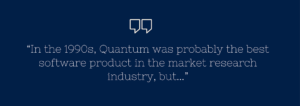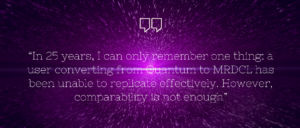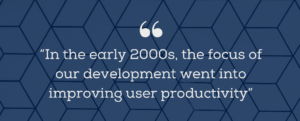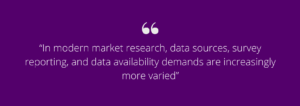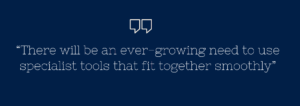
Phil Hearn: Blogger, Writer & Founder of MRDC Software Ltd.
Is Quantum Still The Best Crosstabulation Software For Market Research?
An explanation of why MRDCL may or may not be the right replacement for Quantum.
Hundreds of software platforms now produce crosstabulations (sometimes called crosstabs, tables or tabulations). However, there is a massive difference between what Excel and top-end tabulation software products like Quantum, MRDCL, and Merlin can produce in terms of crosstabs. What are those differences? They break down into five categories:
- Ease and speed of handling large volumes of data, tables or questions/variables
- Table options (percentage options, significance testing, statistics, ranking, weighting etc.)
- Complex data (e.g. multiple streams of data, hierarchical data, occasion-based data such as trips or purchases)
- Short-cut tools for productivity
- The capability of producing any table (by which, I mean more or less any requirement)
My wrong prediction about Quantum
I predicted 20 years ago that as Quantum had been undeveloped for five years and was not supported, it would be dead within five years. How wrong I was. Why was I wrong?
- There was a huge worldwide user base who knew how to make it work efficiently
- It was capable of producing any table
- A single upgrade to Quantum in 2018 arguably saved it from extinction
- Many did not want anything more from their high-end tabulation software
Many did not want anything more from their high-end tabulation software (but do now)
I’ve repeated that last bullet point as a sub-heading to discuss further. Quantum was ahead of its time; it did anything most people wanted. However, I will make another prediction. Although I’m 20 years older and wiser than my previous Quantum prediction, I will stick my neck out and say that Quantum’s life is limited. In the 1990s, Quantum was probably the best software product in the market research industry. It is arguably the best product for its time in market research history, but it is an endangered species as the business changes. Why? Well, I will be explaining how as developers of MRDCL, we see the future of MRDCL and why it is the obvious replacement for Quantum.
Positioning MRDCL
If you know little about MRDCL, let me explain our position. Some see MRDCL as no more than a competitor of Quantum. Yes, MRDCL is a competitor of Quantum. Like Quantum, you can produce any table you want. In 25 years, I can only remember one thing: a user converting from Quantum to MRDCL has been unable to replicate effectively. That one thing was some advanced significance tests that Quantum offered. We have, of course, fixed that now – and, indeed, corrected an erroneous formula in Quantum. But that’s it. However, comparability is not enough.
A brief resume of MRDCL’s last 20 years
Productivity
In the early 2000s, we recognised that while computers and processing power were becoming cheaper, labour costs were increasing significantly in most parts of the world. For this reason, the focus of our development went into improving user productivity. It was a good decision, I feel, as users of MRDCL often note how many ways there are to automate and deskill tasks. More importantly, the automation and templating tools we introduced had the most significant impact on the biggest projects. Some cheaper, easy-to-use products may well reduce the costs of handling a small or straightforward project by, say, 40%, but a 40% saving on labour costs on a large product can make a sizeable impact on profitability.
Project-sharing
One of the most significant weaknesses of any programming or scripting language is that sharing a project is at worst impossible and, at best, inconvenient. MRDCL allows projects to be structured so that different team members can work on different parts of a project. Simplistically, this may mean senior staff working on complex parts and junior staff working on easier aspects of a project. However, it can go beyond that as you can structure your script to make it easy for others to navigate. This facet of MRDCL is important when staff leave, are ill or too busy.
The important bit: the next 10 years
The change
Market research is changing or, more accurately, has changed. Online surveys have brought much of the change in that surveys are generally shorter. However, there are two other more important things. Firstly, data is abundantly available. Users of research, quite reasonably, want to see that data alongside their market research survey data. Secondly, market research is no longer a straight-line process (field, tables, PowerPoint report). In modern market research, data sources, survey reporting, and data availability demands are increasingly more varied. This significant change means that tabulation software, which used to be part of a straight-line process, needs to be more agile.
What we have done already
We have already implemented features that allow MRDCL users to take data from other sources and merge it alongside tabulation survey data. We have also introduced a whole gamut of tools for automation. These tools can be low-level tools such as automating a batch of Excel reports or higher-level exercises. An example would be taking both survey and non-survey data, generating complex variables and analysis and passing that data, or parts of it, to another process or system.
One software product to do everything?
“Ah”, you might say. So, MRDCL doesn’t do everything I will want. My response to this statement is that as market research continues to diversify and business expectations grow, there will be an ever-growing need to use specialist tools that fit together smoothly. I favour using one product rather than two where possible, but using the best tools is essential as long as they connect seamlessly. This thought leads me on to a drum I continue to bang – only use software that lets you in easily and lets you out easily. Connectivity is vital in 2022. Rant over!
What’s next?
Whereas other high-end tabulation systems, such as Quantum, Merlin and Uncle, sit at the end of a straight-line process, we see MRDCL as the hub of your research process. We are increasing our connectivity. Within the software, you will be able to automate PowerPoint presentations within the next year. More importantly, you will have more tools to connect to specialist tools like Tableau and other dashboard systems.
Avoiding the escape to a programming language
One way to expand a product’s capabilities is to allow users access to a programming language like R, Javascript, Visual Basic or C#. Products like Ruby, Confirmit and Research Machine have adopted this approach. Except for specialist projects or very occasional use, we feel this is a dangerous route. It can mean that you can have a whole suite of programs in the hands of one person, who may leave. I have seen this problem several times. We will always deal with improvements within the MRDCL structure.
TSAPI: a new hope
Triple-S has been an excellent interchange format to move data between (mainly) market research software products. It is an initiative we have supported since its inception over 30 years ago. TSAPI is the new kid on the block. It’s early days, but with enough backing, it offers a way to connect market research data to the business world’s data and, of course, vice versa. TSAPI is an API, making it possible to seamlessly connect market research data and business information systems. We will be supporting this initiative wholeheartedly.
Back to Quantum
Older software products, like Quantum, exist as they are the end of a straight-line process. Quantum does connect well to SPSS, but SPSS is like an island as it does not fulfil my criterion of easy to get in and easy to get out. We aim to be at the forefront of the next generation of high-end analysis software. This aim means we need to succeed in four important areas:
- MRDCL is capable of being a hub
- Getting data in and out of MRDCL is seamless
- Productivity remains a priority
- MRDCL improve its internal tools
It’s not as simple as just changing software
Change is painful. Changing from a product like Quantum when you have years of investment will take effort, commitment, and some heartache. However, it is worth understanding the long term benefits rather than being forced to make a hasty or unplanned change. In most cases, these benefits will outweigh any of the heartache you may experience.
If you require any guidance with this topic please get in touch at phil.hearn@mrdcsoftware.com.


